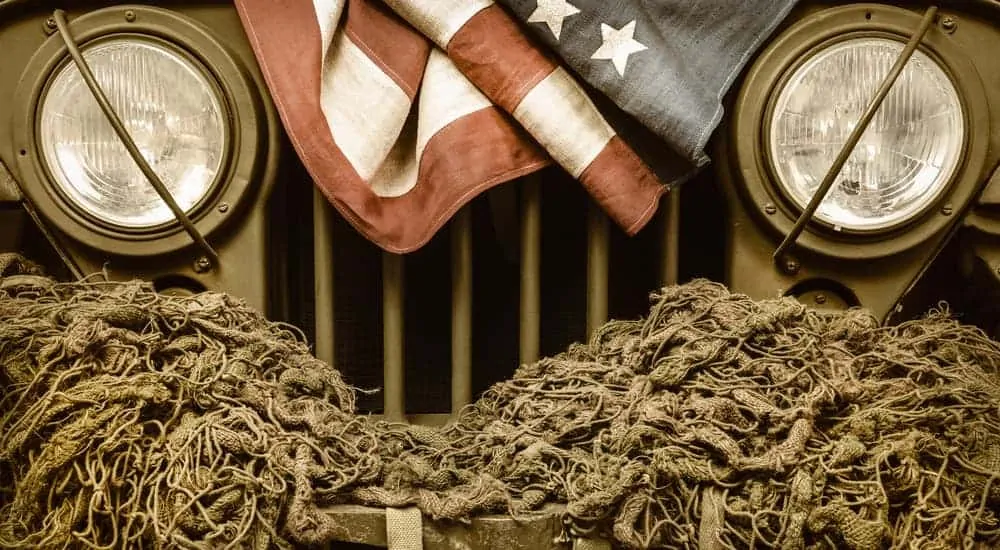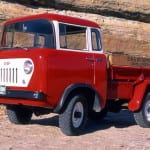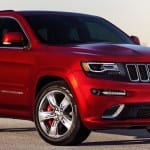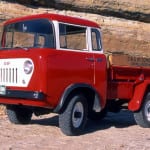What started its life as a military-grade rescue vehicle in the early days of World War II has become the top-tier “anytime, anywhere, any road” vehicle in the world. In fact, for most models of the Jeep, the road part is entirely optional. The very first Jeep 4×4 was designed to navigate gruesome and unpredictable battlefields, and while it was partially domesticated once returning home from war, many Jeep models still celebrate the freedom of leaving the road behind and driving off into the wilderness.
Throughout its history, Jeeps vehicles have been designed to celebrate those who explore—whether that’s on highways or off-road. While some Jeeps were designed to safely deliver an entire family to their destination of choice, other Jeeps are created for pure adventure. With other models, Jeep explored the needs of carrying cargo over rugged terrain. While the modern Jeep models have a more urban flair, there’s still no vehicle that can compare to the all-destination versatility and combat-ready facade that Jeep has trademarked over the past eighty years
The YJ Glory Years: 1987-1995
The Jeep Wrangler replaced the popular CJ series, which was discontinued in 1986. Officially known as the “YJ Series,” the Wrangler was criticized as being a more domesticated version of the CJ series, which earned its stripes when Mark Smith and his crew of thirteen explorers drove from Tierra del Fuego, Chile to Prudhoe Bay, Alaska- a 21,000-mile trip that spanned 122 days. While many were sad to see the CJ series retired, the frenzy for the Wrangler soon kicked into gear.
YJ models may look a lot like their predecessors, but one solid giveaway is the trademark square headlights. These models were also designed to have a lower, wider track and larger axle u-joints, all incorporated to give the Wrangler a little more stability and power no matter where it went. As a testament to the rugged personality of the Wrangler, consider that it wasn’t until 1988 that Jeep added locks to the steel half doors and improved the seals on the soft roofs.
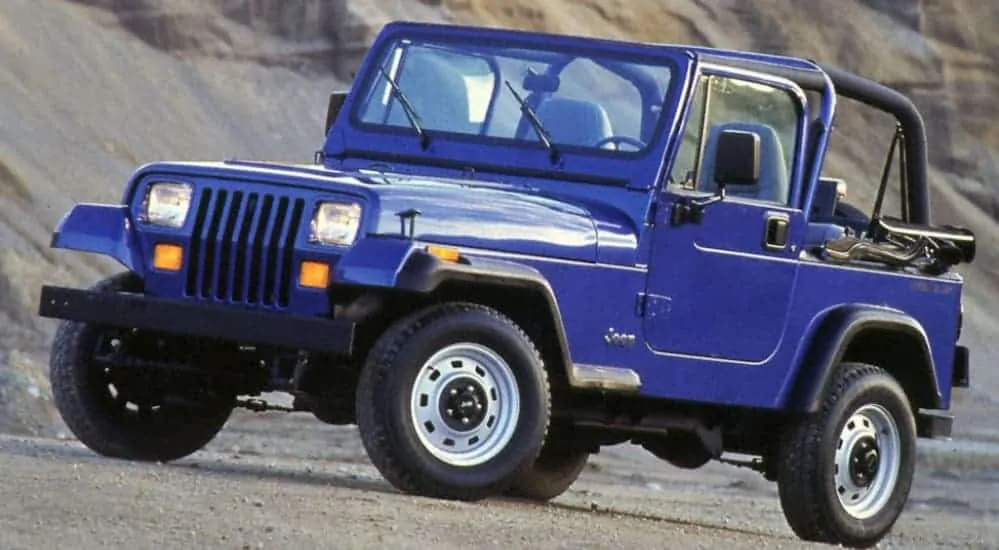
Early trims included the Base (“S” or “SE”), Laredo, Islander, Sport, Sahara, Renegade, and Rio Grande. The differences between these packages were often nominal, but everyone had a favorite. The Islander trim, for example, included tropical-themed stickers and paint jobs, a center console, and the choice between a full and half door. The Renegade, which was introduced in 1990, changed the game a bit, with its optional hard roof and 4.0L I6 engine. The most outstanding feature of the Renegade was that, while it gave the appearance of being an off-road beast, it really could only handle light-duty when departing the pavement.
Engines on the early Wrangler varied, from a 2.5L AMC I4 to a 4.0L engine that offered up to 180 horsepower, which was introduced in 1991. Drivers could choose between a three-speed or five-speed transmission, too. As the years progressed, power increased, and when the YJ model was quietly retired in 1995, it was because the Wrangler was about to get a serious upgrade with the TJ model redesign.
Everyone Has One: The 1993-1998 Jeep Grand Cherokee
In the years between 1993 and 1998, it seemed like absolutely every household had a Jeep Grand Cherokee. It was during this time frame that sport utility vehicles started taking over America, and the Grand Cherokee was just waiting for its day in the sun.
The Grand Cherokee was offered in a variety of trims, including the Laredo, TSI, Limited, and 5.9 Limited. Each trim included a choice of drive systems: 2WD, part-time 4WD, and full 4WD, with features the daily driver required in the mid-1990s, including dual airbags, four-wheel antilock brakes, and even compact disc players.
The first major facelift for the Grand Cherokee occurred in 1996. The grille, fascias, and cladding were all updated and redesigned to give the vehicle a less boxy appearance. While changes to the vehicles stance raised some concern as to whether it has lost its overall stability, the base 4.0L, V6 engine had been re-engineered to offer more torque. It was at this point that sales of the Grand Cherokee topped 1 million.
As the decade came to a close, the Grand Cherokee advanced in popularity. In 1997, Jeep continued to make improvements to the successful formula of the Grand Cherokee, including an optional 5.2L V8 engine on the 2WD models, and some tweaking to the anti-lock brakes.
Leather seats and premium audio packages were added to the top trims, taking this model from a basic, oversized station wagon, to a luxury SUV. The 1998 5.9 Limited was considered “The Ferrari” of sport utility vehicles, in fact, with a 5.9L V8 engine, premium calf leather seats, trim, and console, and an Infinity 10-speaker audio system. While current Grand Cherokee models continue to dominate the roads, these were truly the halcyon days of Jeep’s most popular family vehicle.
The Gladiator: Gone, but Not Forever!
Newer generations of car enthusiasts may not even be aware of the Jeep Gladiator, or J-series pick up. After all, though being introduced in 1962, the name “Gladiator” was dropped after 1971. The Gladiator is actually one of the founding Jeep models that made the military and civilian crossover. The 4000 series was offered with a variety of work-optional equipment packages, turning the truck into a snowplow, a wrecker, or a dump trump.
From the cab forward, the J-series trucks shared the Wagoneer or Cherokee body. A new front axle, six-stud wheels, front disc brakes, and a heavier frame bolstered the bodies of the J-10 and J-20 models, which were offered from 1974 to 1988, continuing the model’s reputation as a very capable on-and-off-road taskmaster.
It might be said that the later generations of the J-series Jeep trucks were some of the most significant, at least in terms of popular culture appreciation. In 1976, the iconic Honcho trim package was offered on the J10 pickup. What may appear to be a very dated late-1970s look today was the height of fashion at the time, with its bold striped exterior, Levi’s denim interior, roll bars and grille, and prominent “Honcho” labeling. The 1977 Golden Eagle trim kept the bold exterior, the roll bar and grille guard, and the Levi’s interior, but added a magnificent eagle decal on the hood. The 1978 “10-4” trim made good on the CB radio fad of its time by installing an optional Citizens’ Band radio.
When Chrysler bought out AMC in 1987, the J-series was discontinued in favor of the much more popular Grand Wagoneer. Since then, there have been a few casual hints that the Gladiator might make a return in the future, which finally became a reality with the 2020 release. While the new iteration of the Gladiator looks more like a Wrangler with a bed than its true pickup truck ancestors, this newest generation has the ability to tow up to 7,650 pounds with true off-road capability, making it just as rugged and mighty as the J4000
The Outstanding Jeep Legacy
Jeep models have an eighty-year reputation for providing a quality, courageous off-road, multi-capable ride. From the original Wrangler to the family-friendly Grand Cherokee, Jeep has managed to keep up with the needs of the people who wander beyond the open road. With the relaunch of the Gladiator truck concept, Jeep proves that moving cargo and moving people doesn’t have to be mutually exclusive, no matter where the off-road may lead.
